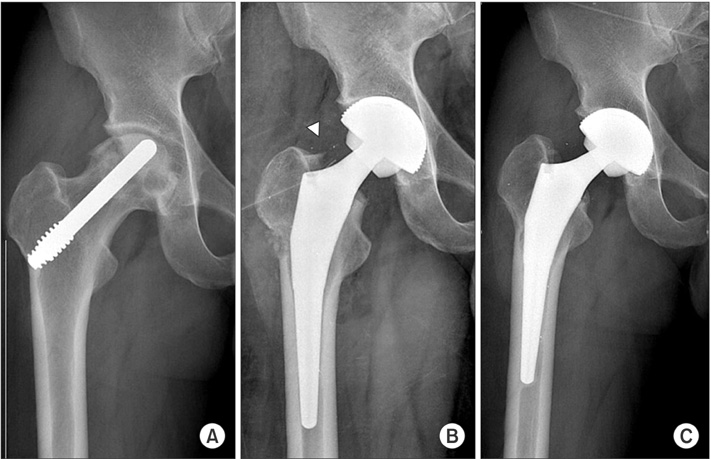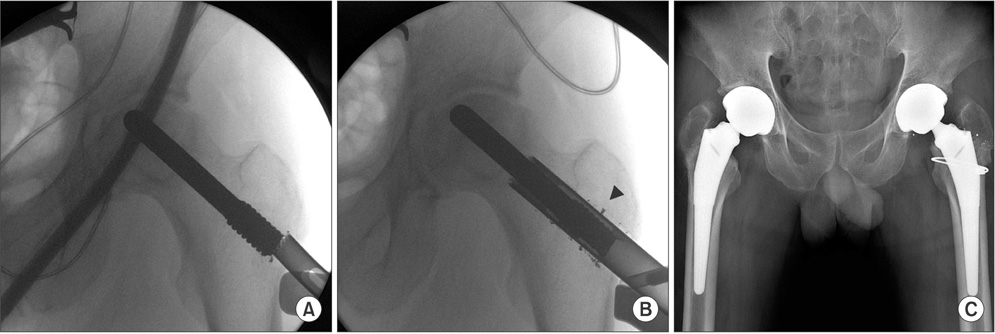Clin Orthop Surg.
2016 Mar;8(1):38-44. 10.4055/cios.2016.8.1.38.
Results of Total Hip Arthroplasty after Core Decompression with Tantalum Rod for Osteonecrosis of the Femoral Head
- Affiliations
-
- 1Department of Orthopedic Surgery, Center for Joint Disease, Chonnam National University Hwasun Hospital, Hwasun, Korea. chiasma@hanmail.net
- 2Department of Traumatology, Neurosurgery, and Military Field Surgery, Samarkand State Medical Institute, Samarkand, Uzbekistan.
- KMID: 2363943
- DOI: http://doi.org/10.4055/cios.2016.8.1.38
Abstract
- BACKGROUND
Early stage osteonecrosis of the femoral head (ONFH) has many treatment options including core decompression with implantation of a tantalum rod. The purpose of this study was to evaluate clinical and radiological outcomes and potential complications during conversion total hip arthroplasty (THA) in such patients.
METHODS
Six male patients (8 hips) underwent THA subsequent to removing a tantalum rod (group I) from April 2010 to November 2011. We retrospectively reviewed the medical records of these patients. We enrolled 12 age- and sex-matched patients (16 hips) during the same period, who had undergone primary THA without a previous operation as the control group (group II). All patients were followed for at least 3 years. We checked the Harris hip score (HHS), operative time, and volume of blood loss. Radiological results, including inclination, anteversion of the acetabular cup, presence of periprosthetic osteolysis, and subsidence of femoral stem were checked at the last follow-up.
RESULTS
The mean preoperative HHS values were 56.5 (range, 50 to 62) and 59.1 (range, 42 to 70) in groups I and II, respectively. The HHS improved to 96.0 (range, 93 to 100) and 97.6 (range, 93 to 100), respectively, at the 3-year follow-up (p = 0.172). Mean operation time was 98.8 minutes (range, 70 to 120 minutes) in group I and 77.5 minutes (range, 60 to 115 minutes) in group II (p = 0.006). Total blood loss volumes were 1,193.8 mL (range, 960 to 1,360 mL) and 944.1 mL (range, 640 to 1,280 mL) in groups I and II, respectively (p = 0.004). No significant differences in inclination or anteversion of acetabular cup and no evidence of osteolysis or subsidence of the femoral stem were reported in either group in radiological follow-up results. However, one case of squeaking occurred in group I during the follow-up.
CONCLUSIONS
The two groups showed no clinical or radiological differences except extended operative time and increased blood loss. However, the incidence of squeaking (1 of 8 hips) was higher, as compared to the control group or previously reported values.
MeSH Terms
-
Adult
*Arthroplasty, Replacement, Hip/adverse effects/methods/statistics & numerical data
Case-Control Studies
*Decompression, Surgical/adverse effects/methods/statistics & numerical data
Femur Head/diagnostic imaging/surgery
Femur Head Necrosis/diagnostic imaging/*surgery
Humans
Male
Postoperative Complications
Reoperation
Retrospective Studies
Tantalum/*therapeutic use
Tomography, X-Ray Computed
Treatment Outcome
Tantalum
Figure
Reference
-
1. Mont MA, Hungerford DS. Non-traumatic avascular necrosis of the femoral head. J Bone Joint Surg Am. 1995; 77(3):459–474.
Article2. Liu Y, Su X, Zhou S, Wang L, Wang C, Liu S. A modified porous tantalum implant technique for osteonecrosis of the femoral head: survivorship analysis and prognostic factors for radiographic progression and conversion to total hip arthroplasty. Int J Clin Exp Med. 2015; 8(2):1918–1930.3. Marker DR, Seyler TM, Ulrich SD, Srivastava S, Mont MA. Do modern techniques improve core decompression outcomes for hip osteonecrosis? Clin Orthop Relat Res. 2008; 466(5):1093–1103.
Article4. Floerkemeier T, Lutz A, Nackenhorst U, et al. Core decompression and osteonecrosis intervention rod in osteonecrosis of the femoral head: clinical outcome and finite element analysis. Int Orthop. 2011; 35(10):1461–1466.
Article5. Varitimidis SE, Dimitroulias AP, Karachalios TS, Dailiana ZH, Malizos KN. Outcome after tantalum rod implantation for treatment of femoral head osteonecrosis: 26 hips followed for an average of 3 years. Acta Orthop. 2009; 80(1):20–25.
Article6. Papapietro N, Di Martino A, Niccoli G, et al. Trabecular metal screw implanted for avascular necrosis of the femoral head may complicate subsequent arthroplasty surgery. Eur J Orthop Surg Traumatol. 2014; 24(6):931–938.
Article7. Owens JB, Ely EE, Guilliani NM, Suarez JC, Patel PD. Removal of trabecular metal osteonecrosis intervention implant and conversion to primary total hip arthroplasty. J Arthroplasty. 2012; 27(6):1251–1253.
Article8. ARCO (Association Research Circulation Osseous). Committee on Terminology and Classification. ARCO News. 1992; 4:41–46.9. Yoon TR, Bae BH, Choi MS. A modified two-incision minimally invasive total hip arthroplasty: technique and short-term results. Hip Int. 2006; 16:Suppl 4. 28–34.
Article10. Harris WH. Traumatic arthritis of the hip after dislocation and acetabular fractures: treatment by mold arthroplasty. An end-result study using a new method of result evaluation. J Bone Joint Surg Am. 1969; 51(4):737–755.
Article11. Gruen TA, McNeice GM, Amstutz HC. "Modes of failure" of cemented stem-type femoral components: a radiographic analysis of loosening. Clin Orthop Relat Res. 1979; (141):17–27.12. Callaghan JJ, Salvati EA, Pellicci PM, Wilson PD Jr, Ranawat CS. Results of revision for mechanical failure after cemented total hip replacement, 1979 to 1982: a two to five-year follow-up. J Bone Joint Surg Am. 1985; 67(7):1074–1085.
Article13. DeLee JG, Charnley J. Radiological demarcation of cemented sockets in total hip replacement. Clin Orthop Relat Res. 1976; (121):20–32.
Article14. Kim JO, Noh KJ, Park HS, Do NH, Kim TH, Son HS. Early clinical results in the use of a tantalum trabecular metal system for osteonecrosis of the femoral head. J Korean Hip Soc. 2009; 21(2):141–147.
Article15. Tsao AK, Roberson JR, Christie MJ, et al. Biomechanical and clinical evaluations of a porous tantalum implant for the treatment of early-stage osteonecrosis. J Bone Joint Surg Am. 2005; 87:Suppl 2. 22–27.
Article16. Tanzer M, Bobyn JD, Krygier JJ, Karabasz D. Histopathologic retrieval analysis of clinically failed porous tantalum osteonecrosis implants. J Bone Joint Surg Am. 2008; 90(6):1282–1289.
Article17. Papapietro N, Di Martino A, Niccoli G, et al. Trabecular metal screw implanted for avascular necrosis of the femoral head may complicate subsequent arthroplasty surgery. Eur J Orthop Surg Traumatol. 2014; 24(6):931–938.
Article18. Aluisio FV, Urbaniak JR. Proximal femur fractures after free vascularized fibular grafting to the hip. Clin Orthop Relat Res. 1998; (356):192–201.
Article19. Meneghini RM, Ford KS, McCollough CH, Hanssen AD, Lewallen DG. Bone remodeling around porous metal cementless acetabular components. J Arthroplasty. 2010; 25(5):741–747.
Article20. Walter WL, Kurtz SM, Esposito C, et al. Retrieval analysis of squeaking alumina ceramic-on-ceramic bearings. J Bone Joint Surg Br. 2011; 93(12):1597–1601.
Article21. Hamilton WG, McAuley JP, Dennis DA, Murphy JA, Blumenfeld TJ, Politi J. THA with Delta ceramic on ceramic: results of a multicenter investigational device exemption trial. Clin Orthop Relat Res. 2010; 468(2):358–366.
Article22. McDonnell SM, Boyce G, Bare J, Young D, Shimmin AJ. The incidence of noise generation arising from the largediameter Delta Motion ceramic total hip bearing. Bone Joint J. 2013; 95(2):160–165.
Article23. Tai SM, Munir S, Walter WL, Pearce SJ, Walter WK, Zicat BA. Squeaking in large diameter ceramic-on-ceramic bearings in total hip arthroplasty. J Arthroplasty. 2015; 30(2):282–285.
Article24. Kang BJ, Ha YC, Hwang SC, Lee YK, Koo KH. Midterm results of large diameter Biolox forte ceramic head on delta ceramic liner articulation in total hip arthroplasty. J Arthroplasty. 2014; 29(12):2412–2414.
Article25. Park KS, Seon JK, Yoon TR. The survival analysis in third-generation ceramic-on-ceramic total hip arthroplasty. J Arthroplasty. 2015; 30(11):1976–1980.
Article26. Nevelos J, Ingham E, Doyle C, et al. Microseparation of the centers of alumina-alumina artificial hip joints during simulator testing produces clinically relevant wear rates and patterns. J Arthroplasty. 2000; 15(6):793–795.
Article27. Glaser D, Komistek RD, Cates HE, Mahfouz MR. A noninvasive acoustic and vibration analysis technique for evaluation of hip joint conditions. J Biomech. 2010; 43(3):426–432.
Article28. Nakai T, Liu N, Fudo K, Mohri T, Kakiuchi M. Early complications of primary total hip arthroplasty in the supine position with a modified Watson-Jones anterolateral approach. J Orthop. 2014; 11(4):166–169.
Article29. Capello WN, D'Antonio JA, Feinberg JR, Manley MT, Naughton M. Ceramic-on-ceramic total hip arthroplasty: update. J Arthroplasty. 2008; 23:7 Suppl. 39–43.
Article
- Full Text Links
- Actions
-
Cited
- CITED
-
- Close
- Share
- Similar articles
-
- Hip Resurfacing Arthroplasty after Failure of Tantalum Rod Insertion in Patients with Osteonecrosis of the Femoral Head
- Early Clinical Results in the Use of a Tantalum Trabecular Metal System For Osteonecrosis of the Femoral Head
- Core Decompression on Osteonecrosis of Femoral Head
- Total Hip Arthroplasty in Patient with Osteonecrosis of the Femoral Head Following Liver Transplantation: Case Report
- Arthroplasty in Femoral Head Osteonecrosis




